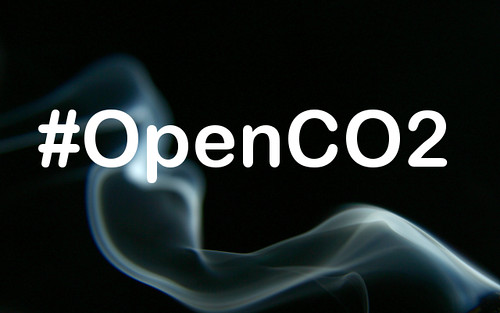
Last week the average concentration of carbon dioxide in the atmosphere reached 400 parts per million, a level which is said to be unprecedented in human history.
Leading scientists and policy makers say that we should be aiming for no more than 350 parts per million to avoid catastrophic runaway climate change.
But what’s in a number? Why is the increase from 399 to 400 significant?
While the actual change is mainly symbolic (and some commentators have questioned whether we’re hovering above or just below 400), the real story is that we are badly failing to cut emissions fast enough.
Given the importance of this number, which represents humanity’s progress towards tackling one of the biggest challenges we currently face – the fact that it has been making the news around the world is very welcome indeed.
Why don’t we hear about the levels of carbon dioxide in the atmosphere from politicians or the press more often? While there are regularly headlines about inflation, interest and unemployment, numbers about carbon emissions rarely receive the level of attention that they deserve.
We want this to change. And we think that having more timely and more detailed information about carbon emissions is essential if we are to keep up pressure on the world’s governments and companies to make the cuts that the world needs.
As our Advisory Board member Hans Rosling puts it, carbon emissions should be on the world’s dashboard.
Over the coming months we are going to be planning and undertaking activities to advocate for the release of more timely and granular carbon emissions data. We are also going to be working with our global network to catalyse projects which use it to communicate the state of the world’s carbon emissions to the public.
If you’d like to join us, you can follow #OpenCO2 on Twitter or sign up to our open-sustainability mailing list:
Image credit: Match smoke by AMagill on Flickr. Released under Creative Commons Attribution license.
Dr. Jonathan Gray is Lecturer in Critical Infrastructure Studies at the Department of Digital Humanities, King’s College London, where he is currently writing a book on data worlds. He is also Cofounder of the Public Data Lab; and Research Associate at the Digital Methods Initiative (University of Amsterdam) and the médialab (Sciences Po, Paris). More about his work can be found at jonathangray.org and he tweets at @jwyg.









what is wrong with http://www.esrl.noaa.gov/gmd/dv/data/ and http://www.ncdc.noaa.gov/oa/about/open-access-climate-data-policy.pdf ?
And there is http://www.ipcc-data.org/ if you want to have the computer models.
And there is http://cuongnt.webchuyennghiep.net/phu-kien-laptop-gia-re if you want to have the accessories for your laptop
I am not sure that more carbon data is what’s needed. There is lots of carbon data and its not on the dashboard because its not priced, and/or we can’t agree a set of national targets which reconcile equity and rapid emission reductions (the two problems are opposite sides of the same coin). More data, more timely or disagregated data isn’t going to solve that.
Sometimes you get breakthroughs in thinking and communication with clever data presentation. Rockstrom and co’s planetary boundaries had done that, as has the Carbon Bubble work on stranded assets. But even then these only function as data-driven metaphors, not yet as new bits of the dashboard of inflation, interest and unemployment numbers etc.. that you rightly say are what people and politicians really pay attention to.
I do agree that OECD should make their energy data open and stop charging for it (we’ve paid for it already).
But innovation in data analysis and presentation of carbon numbers surely has to start with a problem, not just with a conviction that more data will help keep up the pressure (it isn’t working!)
A couple of areas where where I think some more open and beautiful data could be useful are:
1) The corporate carbon disclosures – we have 10 years of corporate carbon reporting. This needs to be made into open data. It would be useful to be able to make sense of corporate carbon reduction targets and performance in relation to their contribution to economic activity (see http://hiyamaya.wordpress.com/2012/12/16/a-little-tweak-to-the-broken-carbon-dashboard/ ). This would allow us to start to make a link between the corporate carbon dashboards, and the global one and stop giving corporations ‘marks for effort’ in managing carbon emissions.
2) On the question of equity for sustainable development -This is an idea whose time seems to have come (http://hiyamaya.wordpress.com/2013/01/06/equitable-access-to-sustainable-development-an-idea-whose-time-has-come/) – and was being discussed with new urgency at the international climate talks in Bonn last month (http://tcktcktck.org/2013/05/jennifer-morgan-encouraging-signs-of-progress-from-bonn-climate-talks/51899) – the talk is of “equity reference frameworks” which allow national emission reductions pledges to be judged against a meaningful yardstick of fairness and adequacy. There have been some very academic presentations of this, but none that yet have the accessibility of a Hans Rosling type presentation, with sliders and toggles and so on for different options.
3) The Center for Global Development has a really interesting proposal for how to finance emission reduction between countries in energy and forests, but with no financial numbers on it – http://international.cgdev.org/page/forest-monitoring-action-forma-and-forest-conservation-performance-ratings-fcpr – I would love to see someone take this model and cost it
Before pushing for more data I would start by trying to identify the problems and opportunities.
My three questions are all about ways to combine data about emissions with information about money/value, time/ambition and equity/fairness. I am sure there are other ways of asking the same question (which may be smarter than mine). But ultimately a dashboard is going to have to combine these four dimensions in a way that helps to guide action and decision making.
BioChar usage in agricultural fields is one solution to excess carbon dioxide.
Please see: http://www.youtube.com/watch?v=iKP_Dju9UK4,
and the International BioChar Initiative at: http://www.biochar-international.org/